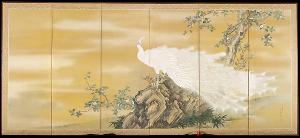Mochizuki Gyokkei
Mochizuki Gyokkei
Place: Kyoto
Born: 1853
Death: 1928
Biography:
Mochizuki Gyokkei was a Japanese artist born in Kyoto in 1853 and died in 1928. He was a master of the Rinpa school, a decorative art style that emerged in Japan in the 17th century. Gyokkei was known for his use of gold leaf and bright colors in his paintings, which often depicted birds and flowers. His work was influenced by traditional Japanese art as well as Western styles.
Life and Career
Gyokkei was born into a family of artists and was trained in the traditional Japanese painting techniques from a young age. He was particularly drawn to the Rinpa school, which emphasized the use of bold colors and gold leaf to create intricate and beautiful designs. Gyokkei's paintings often featured birds and flowers, which were popular motifs in Japanese art. Gyokkei was also influenced by Western art styles, which he encountered through his studies of Nihonga, a Japanese style of painting that emerged during the Meiji period (1868-1912). Nihonga artists sought to combine traditional Japanese techniques with Western styles and materials. Gyokkei's use of bright colors and gold leaf was characteristic of this style.
Artistic Style
Gyokkei's paintings were known for their beauty and intricacy. He used a range of techniques, including gold leaf and mineral pigments, to create vibrant colors and textures. His paintings often featured birds and flowers, which were arranged in intricate patterns and designs. Gyokkei's work was also influenced by the Bunjinga Art Movement, which emphasized individual expression and personal interpretation over technical skill. This movement was characterized by its emphasis on literati painting and calligraphy, which Gyokkei incorporated into his own work.
Legacy
Gyokkei's legacy can be seen in the many artists who followed in his footsteps. He was a teacher and had many students who carried on his artistic tradition. His work can also be found in museums such as the Forest Lawn Museum, which is located in Glendale, California. Some of Gyokkei's notable works include Uemura Shōen: Kinuta and Uemura Shōen: Madame Kusunogi Masashige. These paintings showcase Gyokkei's use of gold leaf and bright colors, as well as his emphasis on traditional Japanese motifs.
- Gold leaf was a key component of Gyokkei's artistic style.
- Rinpa school was the decorative art style that Gyokkei was known for.
- Nihonga was the Japanese style of painting that emerged during the Meiji period (1868-1912).
- Bunjinga Art Movement emphasized individual expression and personal interpretation over technical skill.
Gyokkei's work can be found on Wikioo.org, which features a range of his paintings, including Uemura Shōen: Kinuta and Uemura Shōen: Madame Kusunogi Masashige. His legacy continues to inspire artists and art lovers around the world.

